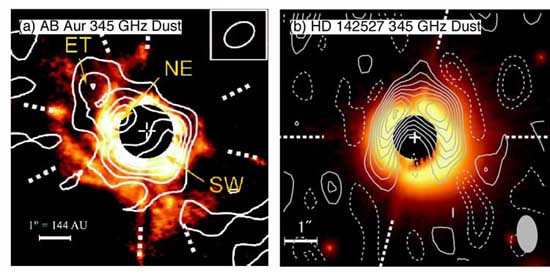|
圖片來源: Lin and Ohashi et al.

Images of circumstellar disks around Herbig Ae stars, obtained in 345 GHz dust emission (contours) using the SMA (AB Aur: Lin et al. 2006, ApJ, 645, 1297, HD 142527: Ohashi et al. 2006 in preparation). Background: coronagraphic images taken by the Subaru
|
| To date, more than 150 extra-solar planets have been discovered. The formation mechanism of these planets has been a pressing and controversial issue in contemporary astrophysics. Circumstellar disks, formed around young stars in the course of their birth, are the most probable sites for future planetary formation. Therefore it is essential for us to observe these disks in detail to understand the formation mechanism of planets. The SMA, with its sub-arcsec resolution, has been playing a crucial role in observations of circumstellar disks. Figure 8 shows SMA images of two nearby Herbig Ae stars, revealing non-axisymmetric structure in their circumstellar disks. These structures offer us a first hint that an incipient planet is being assembled in the disk. |
 asiaa.sinica.edu.tw 媒體連絡: epo
asiaa.sinica.edu.tw 媒體連絡: epo asiaa.sinica.edu.tw
asiaa.sinica.edu.tw